Submitted:
04 May 2023
Posted:
05 May 2023
You are already at the latest version
Abstract
Keywords:
1. Introduction
2. Materials and Methods
2.1. The Study Sites
2.2. CO2 Flux measurements
2.3. The ECOSSE Model
2.4. Model Sensitivity and Attribution
2.5. ECOSSE Evaluation
3. Results and discussion
3.1. Estimated Soil Respiration (Rs) from Reco
3.2. Model Sensitivity and Attribution
3.3. ECOSSE Simulations
4. Conclusions
Supplementary Materials
Author Contributions
Acknowledgments
References
- IPCC (2021). Climate Change 2021: The Physical Science Basis. Contribution of Working Group I to the Sixth Assessment Report of the Intergovernmental Panel on Climate Change. (Cambridge University Press).
- NOAA Climate (2022). National Oceanic and Atmospheric Administration. Climate Change: Atmospheric carbon dioxide. Accessed on 9/11/2022 at: Climate Change: Atmospheric Carbon Dioxide | NOAA Climate.gov.
- Caldeira, K.; Wickett, M.E. Anthropogenic carbon and ocean pH. Nature 2003, 425, 365. [Google Scholar] [CrossRef]
- Byrne, R.H.; Mecking, S.; Feely, R.A.; Liu, X. Direct observations of basin-wide acidification of the North Pacific Ocean. Geophysical Research Letter 2010, 37, L02601. [Google Scholar] [CrossRef]
- Hofmann, G.E.; Smith, J.E.; Johnson, K.S.; Send, U.; Levin, L.A.; et al. High-Frequency Dynamics of Ocean pH: A Multi-Ecosystem Comparison. PLoS ONE 2011, 6, e28983. [Google Scholar] [CrossRef] [PubMed]
- Schils, R.L.M.; Bufe, C.; Rhymer, C.M.; Francksen, R.M.; Klaus, V.H.; Abdalla, M.; et al. Permanent grasslands in Europe: Land use change and intensification decrease their multifunctionality. Agriculture, Ecosystems & Environment 2022, 330, 107891. [Google Scholar]
- European commission (2020). Directorate-General for Agriculture and Rural Development. Commission publishes external study on future of EU livestock (europa.eu).
- Soussana, J.-F.; Tallec, T.; Blanfort, V. Mitigating the greenhouse gas balance of ruminant production systems through carbon sequestration in grasslands. International Journal of Animal Biosciences 2010, 4, 334–350. [Google Scholar] [CrossRef]
- Van Den Pol, A., Becker, T., Botana Fernandez, A., Hennessy, T., Peratoner, G. (2018). Social and economic impacts of grass based ruminant production. In: Horan, B., Hennessy, D., O’Donovan, M., Kennedy, E., McCarthy, B., Finn, J.A., O’Brien, B. (Eds.), 27th European Grassland Federation General Meeting Cork (EGF 2018). European Grassland Federation EGF, Zürich, pp. 697–708.
- Hussain, R.I.; Walcher, R.; Eder, R.; Allex, B.; Wallner, P.; Hutter, H.-P.; Bauer, N.; Arnberger, A.; Zaller, J.G.; Frank, T. Management of mountainous meadows associated with biodiversity attributes, perceived health benefits and cultural ecosystem services. Scientific Reports 2019, 9, 14977. [Google Scholar] [CrossRef]
- Eurostat (2020). Share of main land types in utilised agricultural area (UAA) by NUTS 2 regions.
- Eurostat (2013). Eurostat regional yearbook 2013. Access at: KS-HA-13-001-EN.PDF (europa.eu).
- Follett, R.F.; Reed, D. A. Soil Carbon Sequestration in Grazing Lands: Societal Benefits and Policy Implications. Rangeland Ecology and Management 2010, 63, 4–15. [Google Scholar] [CrossRef]
- Conant, R.T. Cerri, C.E.P. Osborne B.B.; Paustian, K. Grassland management impacts on soil carbon stocks: a new synthesis. Ecological Applications 2017, 27, 662–668. [Google Scholar] [CrossRef]
- Abdalla, M.; Espenberg, M.; Zavattaro, L.; Lellei-Kovacs, E.; Mander, U.; Smith, K.; et al. Does liming grasslands increase biomass productivity without causing detrimental impacts on net greenhouse gas emissions? Environmental Pollution 2022, 118999. [Google Scholar] [CrossRef] [PubMed]
- Folger, P. (2009). The carbon cycle: Implications for climate change and congress. CRS report for congress. Access at: www.fas.org/sgp/crs/misc/RL34059.pdf.
- Wang, W.; Fang, J. Soil respiration and human effects on global grasslands. Global Planetary Change 2009, 67, 20–28. [Google Scholar] [CrossRef]
- Bernhardt, E.S.; Barber, J.J.; Pippen, J.S.; Taneva, L.; Andrews, J.A.; Schlesinger, W.H. Long-term effects of Free Air CO2 Enrichment (FACE) on soil respiration. Biogeochemistry 2006, 77, 91–116. [Google Scholar] [CrossRef]
- Abdalla, M.; Hastings, A.; Bell, M.J.; Smith, J.U.; Richards, M.; Nilsson, M.B.; Peichl, M.; Löfvenius, M.O.; Lund, M.; Helfter, C.; et al. Simulation of CO2 and attribution analysis at six European peatland sites using the ECOSSE model. Wat, Air Soil Pollution 2014, 225, 2182. [Google Scholar] [CrossRef]
- Meyer, N.; Welp, G.; Amelung, W. The temperature sensitivity (Q10) of soil respiration: Controlling factors and spatial prediction at regional scale based on environmental soil classes. Global Biogeochemical Cycles 2018, 32, 306–323. [Google Scholar] [CrossRef]
- Dacal, M.; Delgado-Baquerizo, M.; Barquero, J.; Berhe, A.A.; Gallardo, A.; Maestre, F.T.; Garcı´a-Palacios, P. Temperature Increases Soil Respiration Across Ecosystem Types and Soil Development, But Soil Properties Determine the Magnitude of This Effect. Ecosystems 2022, 25, 184–198. [Google Scholar] [CrossRef]
- Smith, S.D.; Huxman, T.E.; Zitzer, S.E.; Charlet, T.N.; Housman, D.C.; Coleman, S.; Fenstermaker, L.K.; Seeman, J.R.; Nowak, R.S. Elevated CO2 increases productivity and invasive species success in an arid ecosystem. Nature 2000, 408, 79–82. [Google Scholar] [CrossRef]
- Abdalla, M.; Kumar, S.; Jones, M.; Burke, J.; Williams, M. Testing DNDC model for simulating soil respiration and assessing the effects of climate change on the CO2 gas flux from Irish agriculture. Global and Planetary Change 2011, 78, 106–115. [Google Scholar] [CrossRef]
- Zak, D.R. , Pregitzer, K.S.; King, J.S.; Holmes, W.E. Elevated atmospheric CO2, fine roots and the response of soil microorganisms: a review and hypothesis. New Phytologist 2000, 147, 201–222. [Google Scholar] [CrossRef]
- Jenkinson, D.S.; Rayner, J.H. The turnover of soil organic matter in some of the Rothamsted classical experiments. Soil Science 1977, 123, 298–305. [Google Scholar] [CrossRef]
- Jenkinson, D.S.; Hart, P.B.S.; Rayner, J.H.; Parry, L.C. Modelling the turnover of organic matter in long-term experiments at Rothamsted. Intecol Bulletin 1987, 15, 1–8. [Google Scholar]
- Coleman, K., Jenkinson, D. S. (1996). RothC-26.3: a model for the turnover of carbon in soil. In D. S. Powlson, P. Smith, & J. U. Smith (Eds.), Evaluation of soil organic matter models using existing, long-term datasets, NATO ASI Series I (Vol. 38, pp. 237–246). Heidelberg: Springer.
- Bradbury, N.J.; Whitmore, A.P.; Hart, P.B.S.; Jenkinson, D.S. Modelling the fate of nitrogen in crop and soil in the yearas following the application of 15N-labelled fertilizer to winter wheat. Journal of Agricultural Science 1993, 121, 363–379. [Google Scholar] [CrossRef]
- Smith, J.U.; Glendining, M.J. A decision support system for optimising the use of nitrogen in crop rotations. Rotations and cropping systems. Aspects of Applied Biology 1996, 47, 103–110. [Google Scholar]
- Smith, J.; Gottschalk, P.; Bellarby, J.; Richards, M.; Nayak, D.; Coleman, K.; Hillier, J.; Wattenbach, M.; Aitkenhead, M.; Yeluripurti, J.; Farmer, J.; Smith, P. Model to estimate carbon in organic soils-sequestration and emissions (ECOSSE) user-manual (pp. 1-76). UK: University of Aberdeen. 2010.
- Reth, S.; Riechstein, M.; Falge, E. The effect of soil water content, soil temperature, soil pH-value and the root mass on soil CO2 efflux – A modified model. Plant Soil 2005, 268, 21–33. [Google Scholar] [CrossRef]
- McMillen, R.T. An eddy correlation technique with extended applicability to non-simple terrain. Bound Layer Meteorology 1988, 43, 231–245. [Google Scholar] [CrossRef]
- Aubinet, M., Vesala,T., Papale, D. (2012). Eddy Covariance: A Practical Guide to Measurement and Data Analysis (Eds.). Spring Atmospheric Science, ISSN 2194-5217.
- Jones, S.K.; Helfter, C.; Anderson, M.; Coyle, M.; Campbell, C.; Famulari, D.; Di Marco, C.; van Dijk, N.; Topp, C.F.E.; Kiese, R.; et al. The nitrogen, carbon and greenhouse gas budget of a grazed, cut and fertilised temperate grassland. Biogeosciences 2017, 14, 2069–2088. [Google Scholar] [CrossRef]
- Hiller, R.; Zeeman, M.J.; Eugster, W. Eddy-covariance flux measurements in the complex terrain of an alpine valley in Switzerland. Bound. -Layer Meteorology 2008, 127, 449–467. [Google Scholar] [CrossRef]
- Wohlfahrt, G.; Anderson-Dunn, M.; Bahn, M.; et al. Biotic, abiotic and management controls on the net ecosystem CO2 exchange of European mountain grasslands. Ecosystems 2008, 11, 1338–1351. [Google Scholar] [CrossRef]
- Fuchs, K.; Hörtnagl, L.; Buchmann, N.; Eugster, W.; Snow, V.; Merbold, L. Management matters: Testing a mitigation strategy for nitrous oxide emissions using legumes on intensively managed grassland. Biogeosciences 2018, 15, 5519–5543. [Google Scholar] [CrossRef]
- Pintér, K.; Barcza, Z.; Balogh, J.; Czóbel, S.; Csintalan, Z.; Tuba, Z.; Zoltán, N. Interannual variability of grasslands’ carbon balance depends on soil type. Community Ecology 2008, 9, 43–48. [Google Scholar] [CrossRef]
- Hirl, R.T.; Schnyder, H.; Ostler, U.; Schäufele, R.; Schleip, I.; Vetter, S.; Auerswald, K.; Baca Cabrera, J.C.; Wingate, L.; Barbour, M.M.; et al. The 18O ecohydrology of a grassland ecosystem – predictions and observations. Hydrology and Earth Systems Science 2019, 23, 2581–2600. [Google Scholar] [CrossRef]
- Čuhel, J.; Šimek, M.; Laughlin, R.J.; Bru, D.; Chèneby, D.; Watson, C.J.; et al. Insights into the effect of soil pH on N2O and N2 emissions and denitrifier community size and activity. Applied and Environmental Microbiology 2010, 76, 1870–1878. [Google Scholar] [CrossRef]
- Balzarolo, M.; Balzarolo, M.; Boussetta, S.; Balsamo, G.; Beljaars, A.; Maignan, F.; Calvet, J.-C.; Lafont, S.; Barbu, A.; Poulter, B.; et al. Evaluating the potential of large-scale simulations to predict carbon fluxes of terrestrial ecosystems over a European Eddy Covariance network. Biogeosciences 2014, 11, 266–2678. [Google Scholar] [CrossRef]
- Hardie, S.M.L.; Garnett, M.H.; Fallick, A.E.; Ostle, N.J.; Rowland, A.P. Bomb 14C analysis of ecosystem respiration reveals that peatland vegetation facilitates release of old carbon. Geoderma 2009, 153, 393–401. [Google Scholar] [CrossRef]
- Wu, L.; McGechan, M.B. A review of carbon and nitrogen processes in four soil nitrogen dynamics models. Journal of Agricultural Engineering Research 1998, 69, 279–305. [Google Scholar] [CrossRef]
- Thornthwaite, C.W. An approach toward a rational classification of climate. Geographical Review 1948, 38, 55–94. [Google Scholar] [CrossRef]
- Smith, J., Smith, P. (2007). Environmental modelling: an introduction. Oxford University Press. UK: pp 1-178.
- Smith, P.; Smith, J.U.; Powlson, D.S.; McGill, W.B.; Arah, J.R.M.; Chertov, O.G.; Coleman, K.; Franko, U.; Frolking, S.; Jenkinson, D.S.; et al. A comparison of the performance of nine soil organic matter models using seven long-term experimental datasets. Geoderma 2007, 81, 153–225. [Google Scholar] [CrossRef]
- Cai, Z.; Swamoto, T.; Li, C.; Kang, G.; Boonjawat, J.; Mosier, A.; Wassmann, R.; Tsuruta, H. Field validation of the DNDC-model for greenhouse gas emissions in East Asian cropping systems. Global Biogeochemical Cycles 2003, 17, 1107. [Google Scholar] [CrossRef]
- Schär, C.; Vidale, P.; Lüthi, D.; Frei, C.; Häberli, C.; Liniger, M.; Appenzeller, C. The role of increasing temperature variability in European summer heatwaves. Nature 2004, 427, 332–336. [Google Scholar] [CrossRef]
- Liu, X.Z.; Wan, S.Q.; Su, B.; Hui, D.F.; Luo, Y.Q. Response of soil CO2 efflux to water manipulation in a tallgrass prairie ecosystem. Plant and Soil 2002, 240, 213–223. [Google Scholar] [CrossRef]
- Xu, L.K.; Baldocchi, D.D.; Tang, J.W. How soil moisture, rain pulses, and growth alter the response of ecosystem respiration to temperature. Global Biogeochemical Cycles 2004, 18, GB4002. [Google Scholar] [CrossRef]
- Frank, A.B.; Liebig, M.A.; Hanson, J.D. Soil carbon dioxide fluxes in northern semiarid grasslands. Soil Biology and Biochemistry 2002, 34, 1235–1241. [Google Scholar] [CrossRef]
- Solomon, S.; Qin, D.; Manning, M.; Chen, Z.; Marquis, M.; Averyt, K.B.; Tignor, M.; Miller, H.L. IPCC Fourth Assessment Report: Climate Change 2007, Cambridge Univ Press, Cambridge, UK, Climate Change 2007: Working Group I: The Physical Science Basis. 2008.
- Bahn, M.; Rodeghiero, M.; Anderson-Dunn, M.; Dore, S.; Gimeno, C.; Drösler, M.; Williams, M.; Ammann, C.; Berninger, F.; Flechard, C.; et al. Soil Respiration in European Grasslands in Relation to Climate and Assimilate Supply. Ecosystems 2008, 11, 1352–1367. [Google Scholar] [CrossRef] [PubMed]
- Cantarel, A.A.M.; Bloor, J.M.G.; Pommier, T.; Guillaumaud, N.; Moirot, C.; Soussana, J.-F.; Poly, F. Four years of experimental climate change modifies the microbial drivers of N2O fluxes in an upland grassland ecosystem. Global Change Biology 2012, 18, 2520–2531. [Google Scholar] [CrossRef]
- Wieder, W.R.; Bonan, G.B.; Allison, S.D. Global soil carbon projections are improved by modelling microbial processes. Nature Climate Change 2013, 3, 909–912. [Google Scholar] [CrossRef]
- De Goede, R.G.M.; Brussaard, L.; Akkermans, A.D.L. On-farm impact of cattle slurry manure management on biological soil quality. NJAS: Wageningen Journal of Life Sciences 2003, 51, 103–133. [Google Scholar] [CrossRef]
- Asmuß, T.; Bechtold, M.; Tiemeyer, B. On the Potential of Sentinel-1 for High Resolution Monitoring of Water Table Dynamics in Grasslands on Organic Soils. Remote Sensing 2019, 11, 1659. [Google Scholar] [CrossRef]
- Clair, S.B.S.T.; Sudderth, E.A.; Fischer, M.L.; Torn, M.S.; Stuart, S.A.; Salve, R.; Eggett, D.L.; Ackerly, D.D. Soil drying and nitrogen availability modulate carbon and water exchange over a range of annual precipitation totals and grassland vegetation types. Global Change Biology 2009, 15, 3018–3030. [Google Scholar] [CrossRef]
- Davidson, E.A.; Belk, E.; Boone, R.D. Soil water content and temperature as independent or confounded factors controlling soil respiration in a temperate mixed hardwood forest. Global Change Biology 1998, 4, 217–227. [Google Scholar] [CrossRef]
- Shaver, G.R.; Canadell, J.; Chapin, F.S., III; Gurevitch, J.; Harte, J.; Henry, G.; Ineson, P.; Jonasson, S.; Melillo, J.; Pitelka, L.; Rustad, L. Global warming and terrestrial ecosystems: a conceptual framework for analysis. Bioscience 2000, 50, 871–882. [Google Scholar] [CrossRef]
- Shaw, M.R.; Harte, J. Control of litter decomposition in a subalpine meadow-sagebrush steppe ecotone under climate change. Ecological Applications 2001, 11, 1206–1223. [Google Scholar]
- Chen, D.; Li, J.; Lan, Z.; Hu, S.; Bai, Y. Soil acidification exerts a greater control on soil respiration than soil nitrogen availability in grasslands subjected to long-term nitrogen enrichment. Functional Ecology 2016, 30, 658–669. [Google Scholar] [CrossRef]
- Apostolakis, A.; Schöning, I.; Michalzik, B.; Klaus, V.H.; Boeddinghaus, R.S.; Kandeler, E.; Marhan, S.; Bolliger, R.; Fischer, M.; Prati, D.; et al. Drivers of soil respiration across a management intensity gradient in temperate grasslands under drought. Nutrient Cycling in Agroecosystem 2022, 124, 101–116. [Google Scholar] [CrossRef]
- Sankaran, M.; Augustine, D.J. Large herbivores suppress decomposer abundance in a semiarid grazing ecosystem. Ecology 2004, 85, 1052–1061. [Google Scholar] [CrossRef]
- Barneze, A.S.; Abdalla, M.; Whitaker, J.; McNamara, N.P.; Ostle, N.J. Predicted Soil Greenhouse Gas Emissions from Climate X Management Interactions in Temperate Grassland. Agronomy 2022, 12, 3055. [Google Scholar] [CrossRef]
- Moinet, G.Y.K.; Midwood, A.J.; Hunt, J.E.; Rumpel, C.; Millard, P.; Chabbi, A. Grassland Management Influences the Response of Soil Respiration to Drought. Agronomy 2019, 9, 124. [Google Scholar] [CrossRef]
- Sándor, R.; Ehrhardt, F.; Brilli, L.; Carozzi, M.; Recous, S.; Smith, P.; Snow, V.; Soussana, J.-F.; Dorich, C.D.; Fuchs, K.; et al. The use of biogeochemical models to evaluate mitigation of greenhouse gas emissions from managed grasslands. Science of the Total Environment 2018, 642, 292–306. [Google Scholar] [CrossRef]
- Subke, J.A.; Bahn, M. On the ‘temperature sensitivity’ of soil respiration: Can we use the immeasurable to predict the unknown? Soil Biology and Biochemistry 2010, 42, 1653–1656. [Google Scholar] [CrossRef]
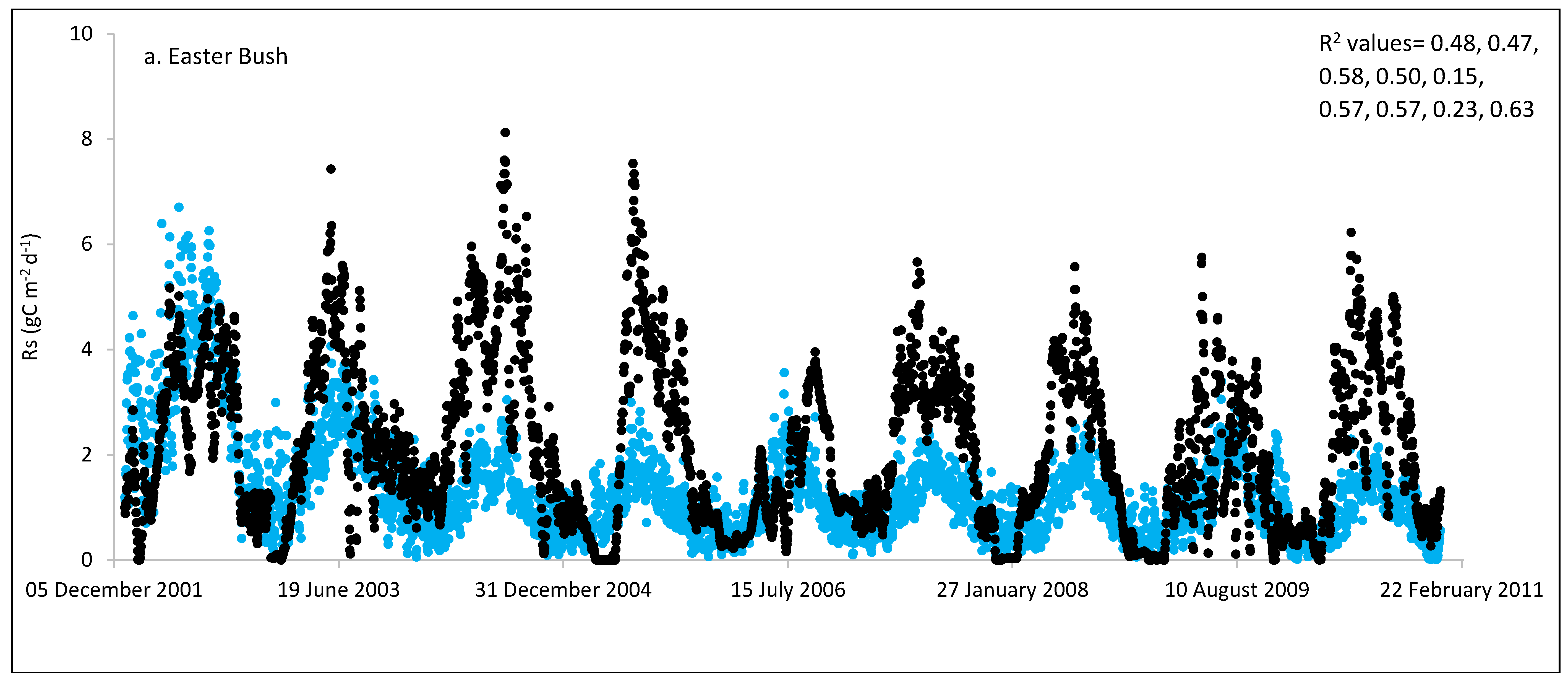
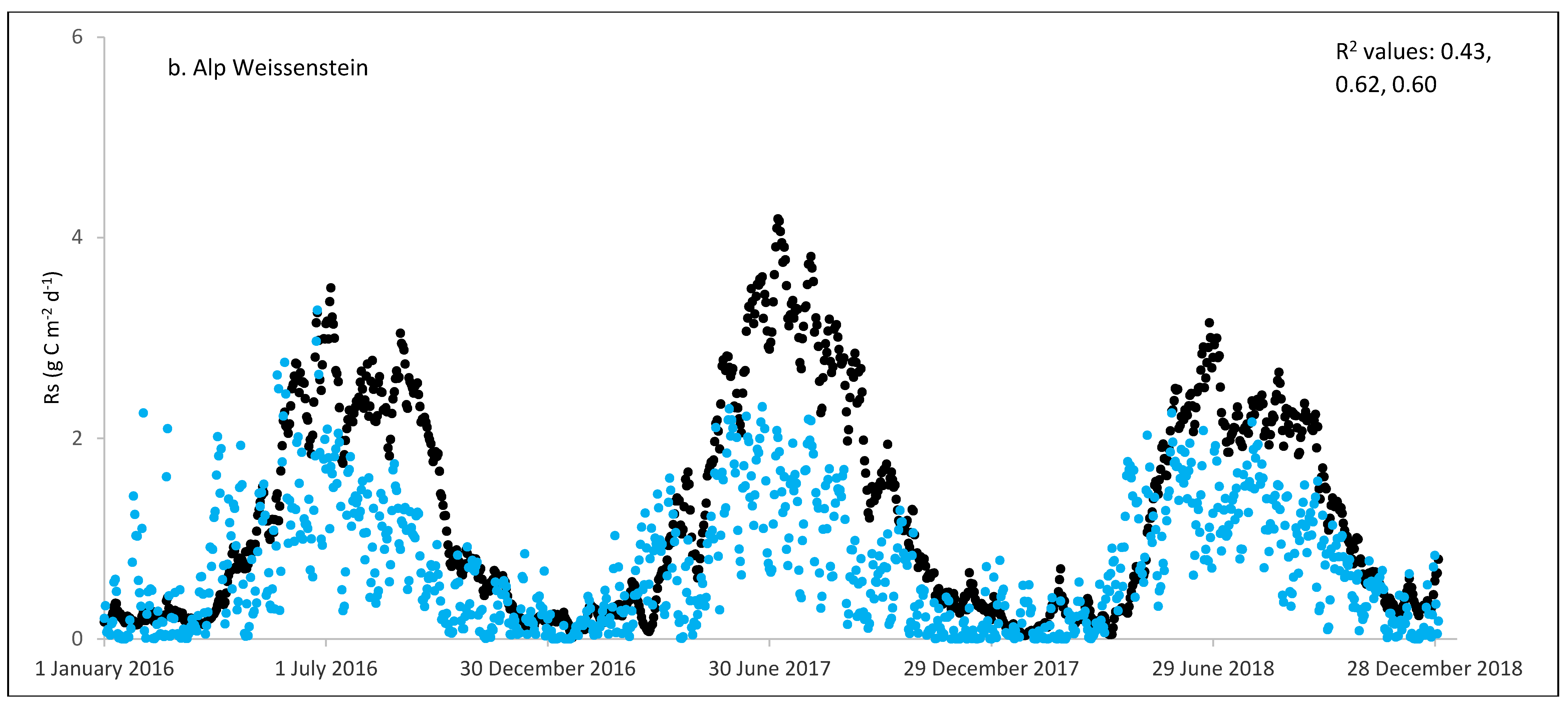
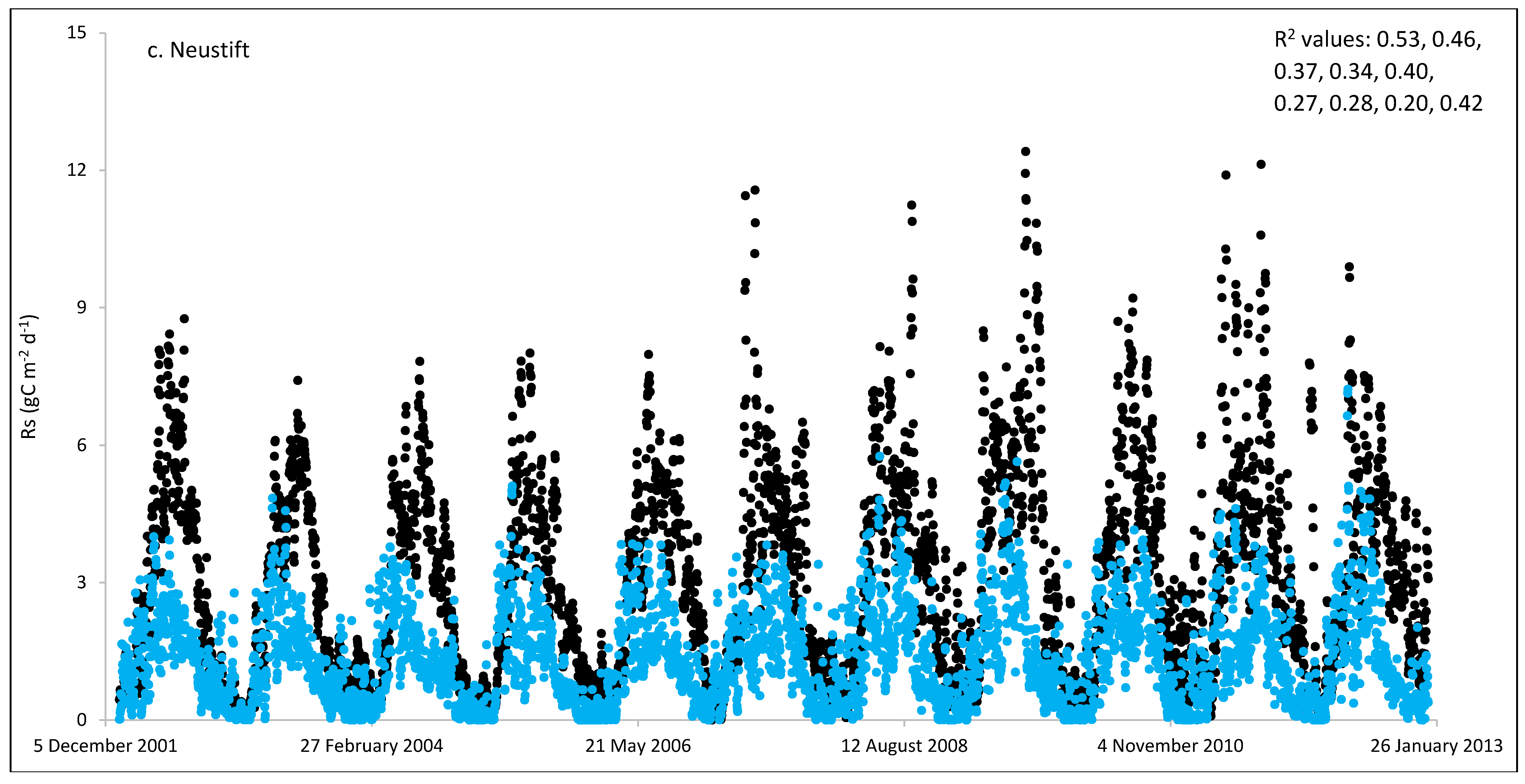
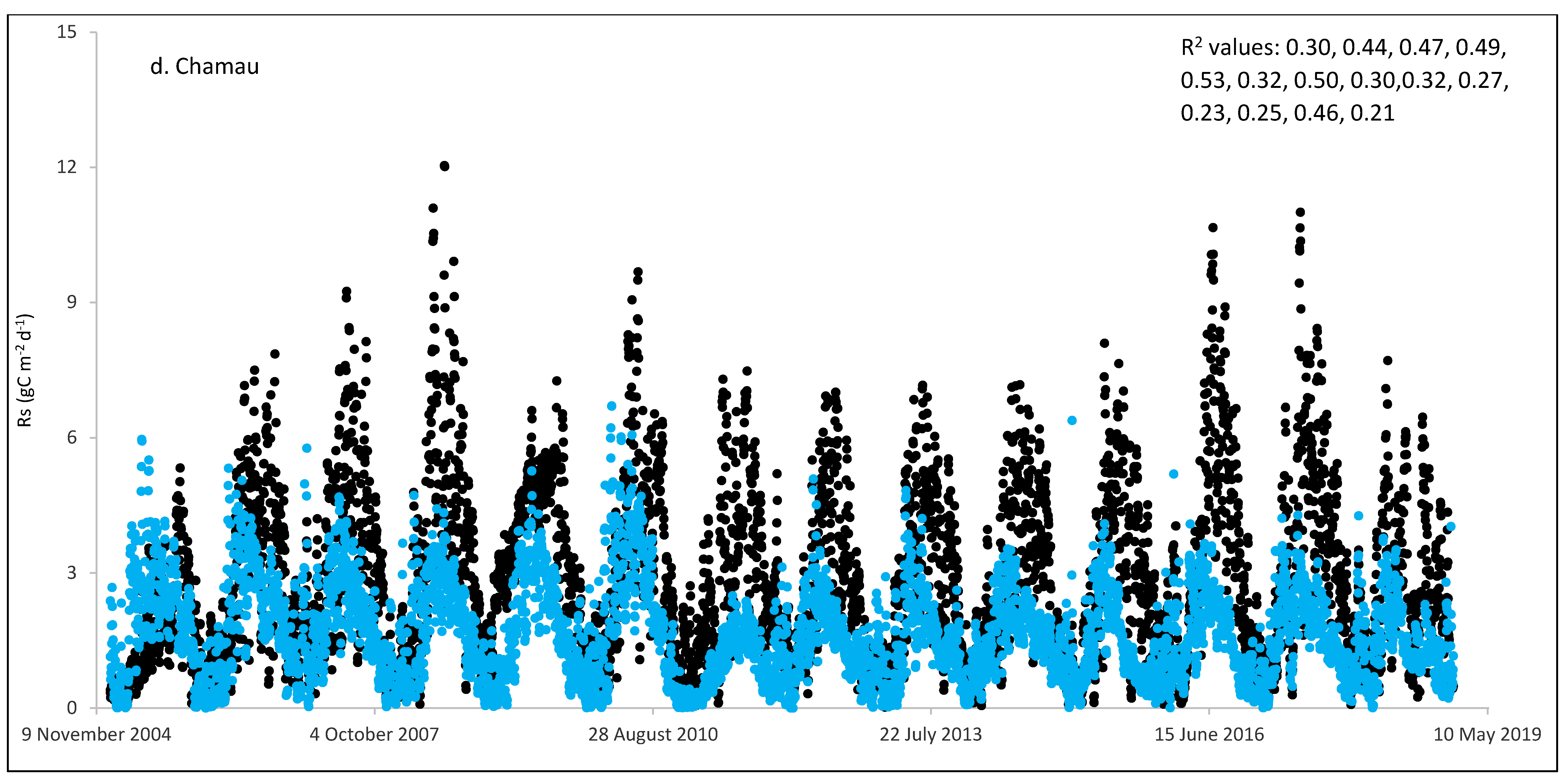
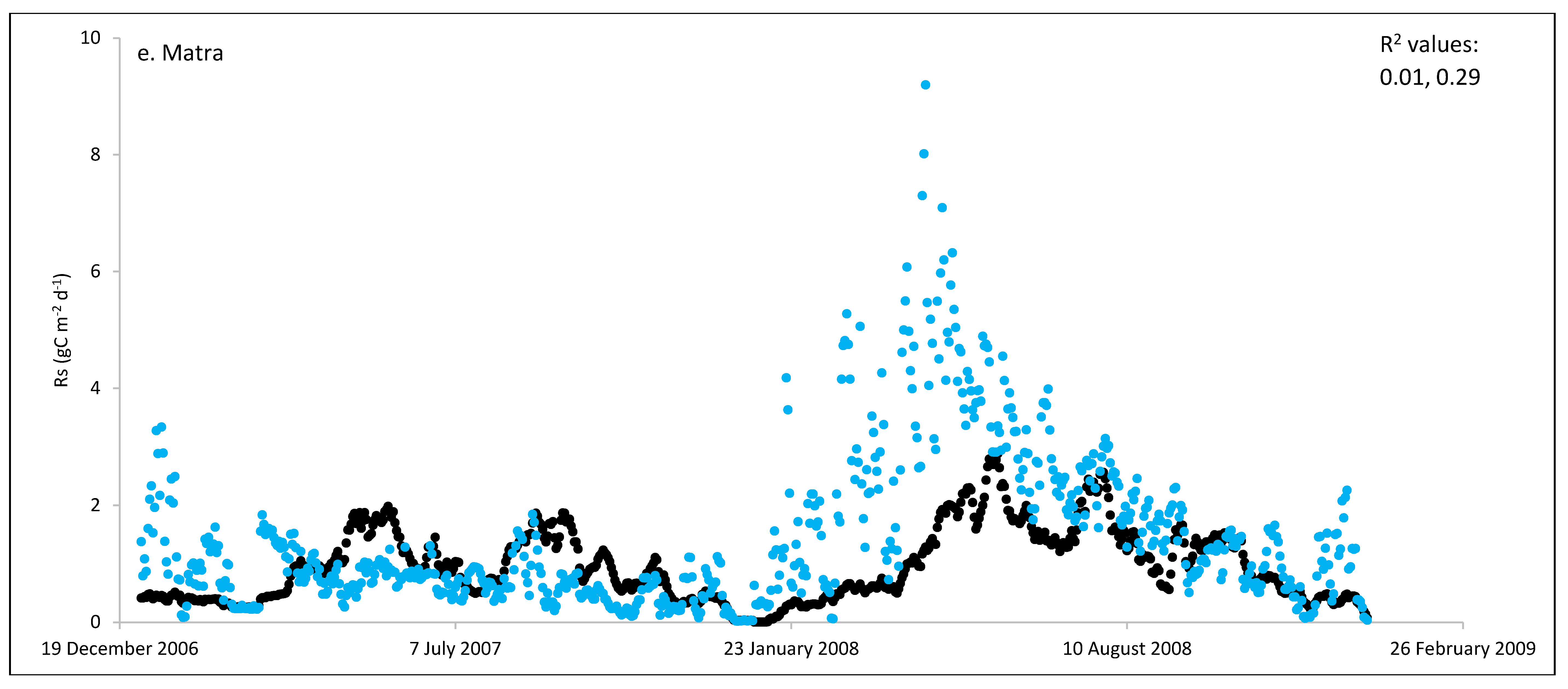
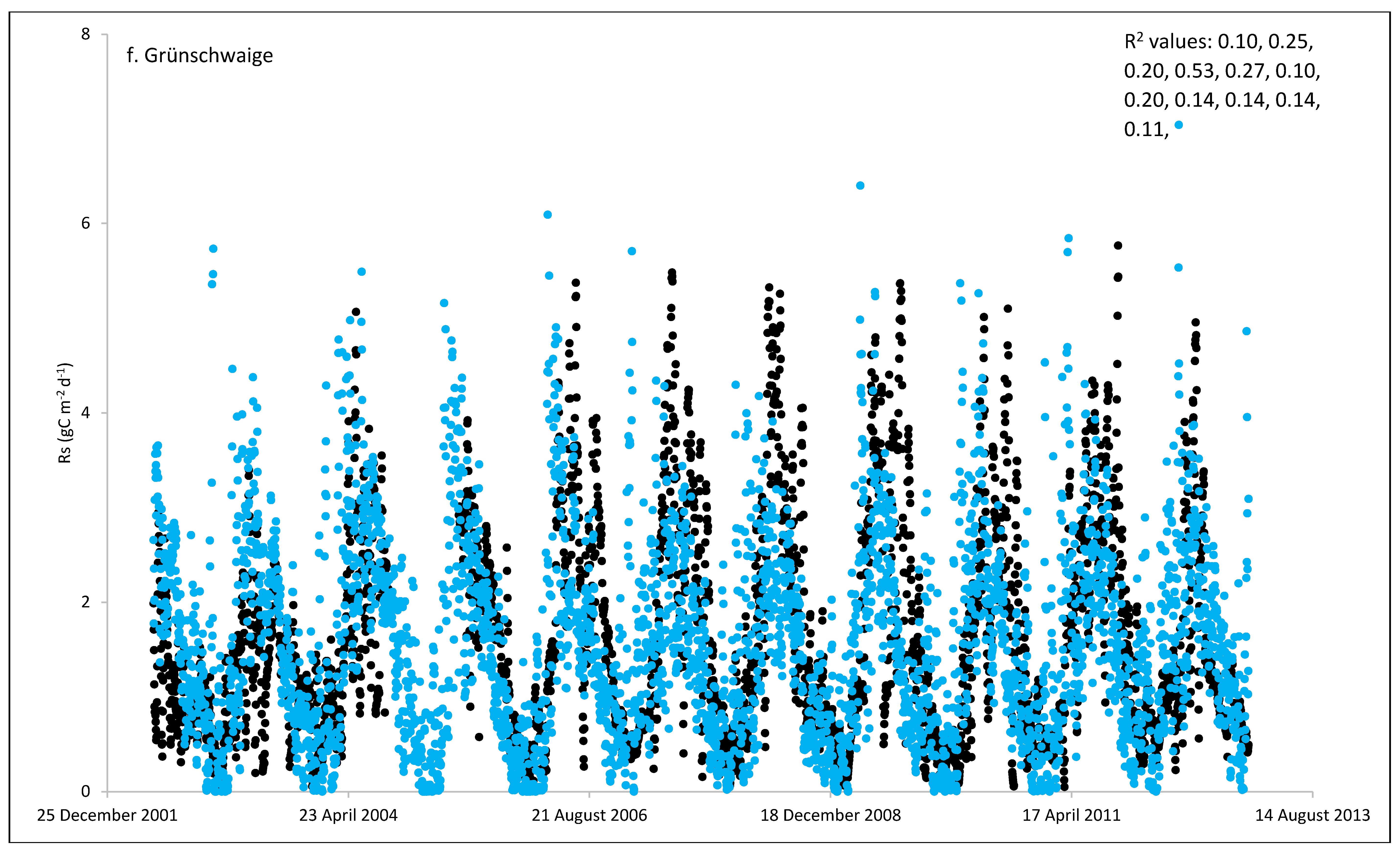
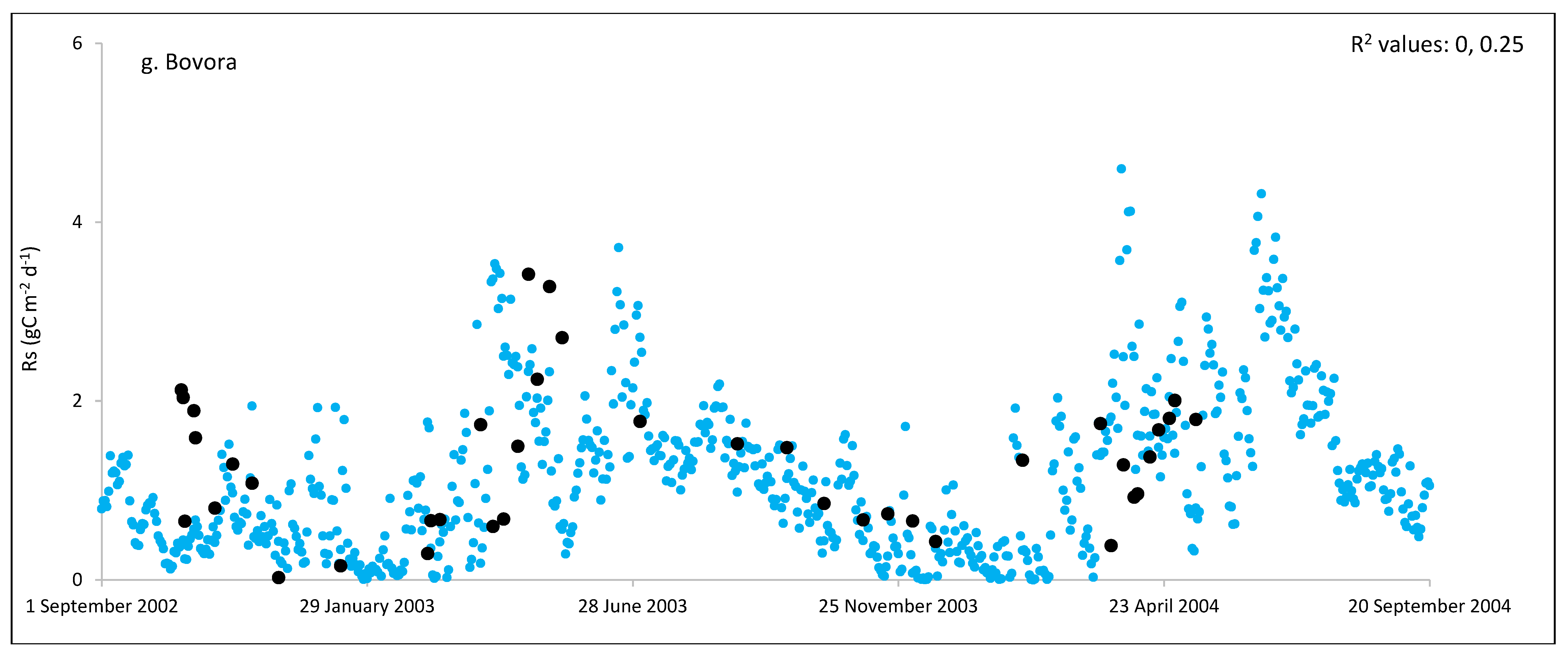
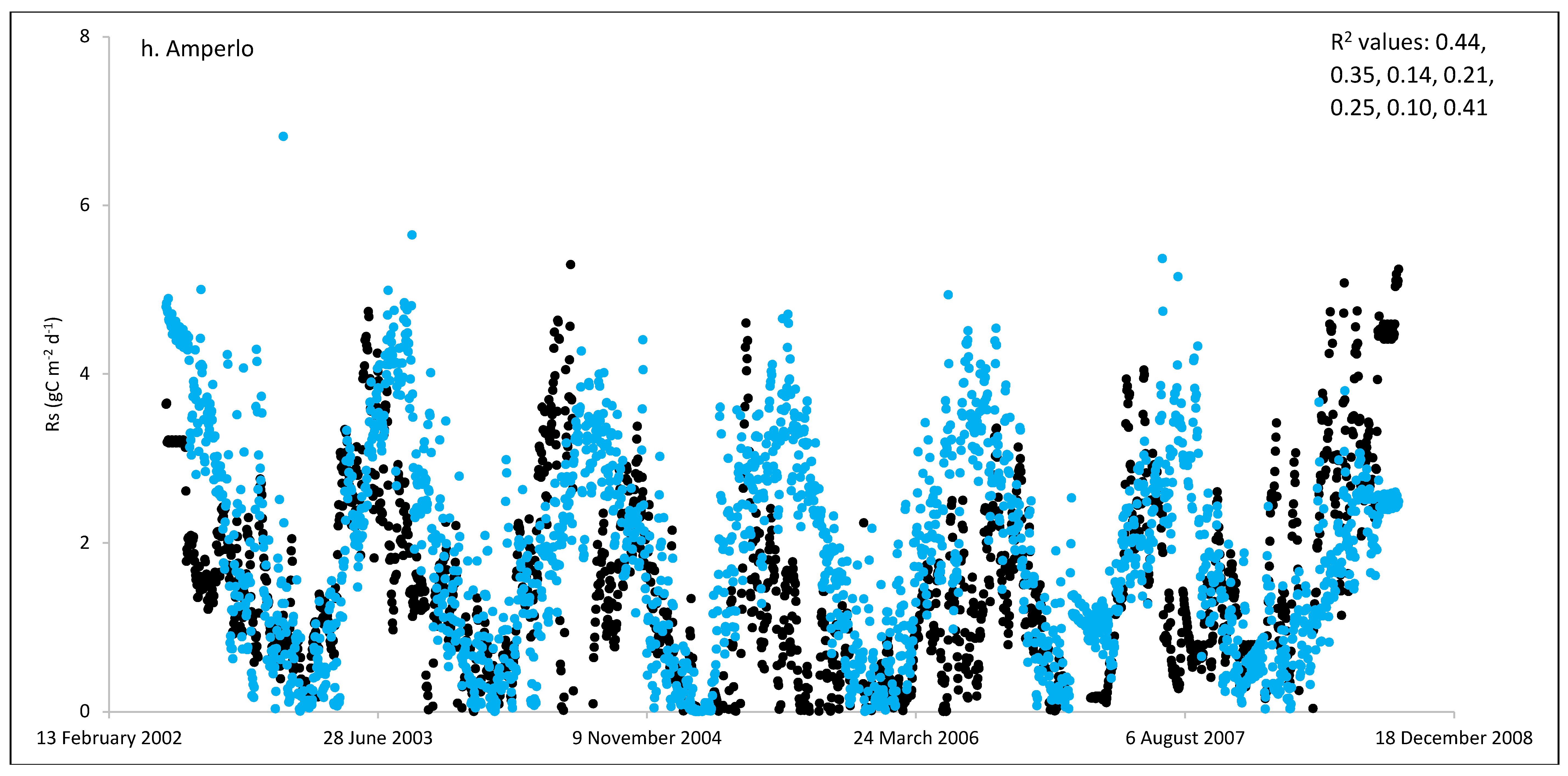
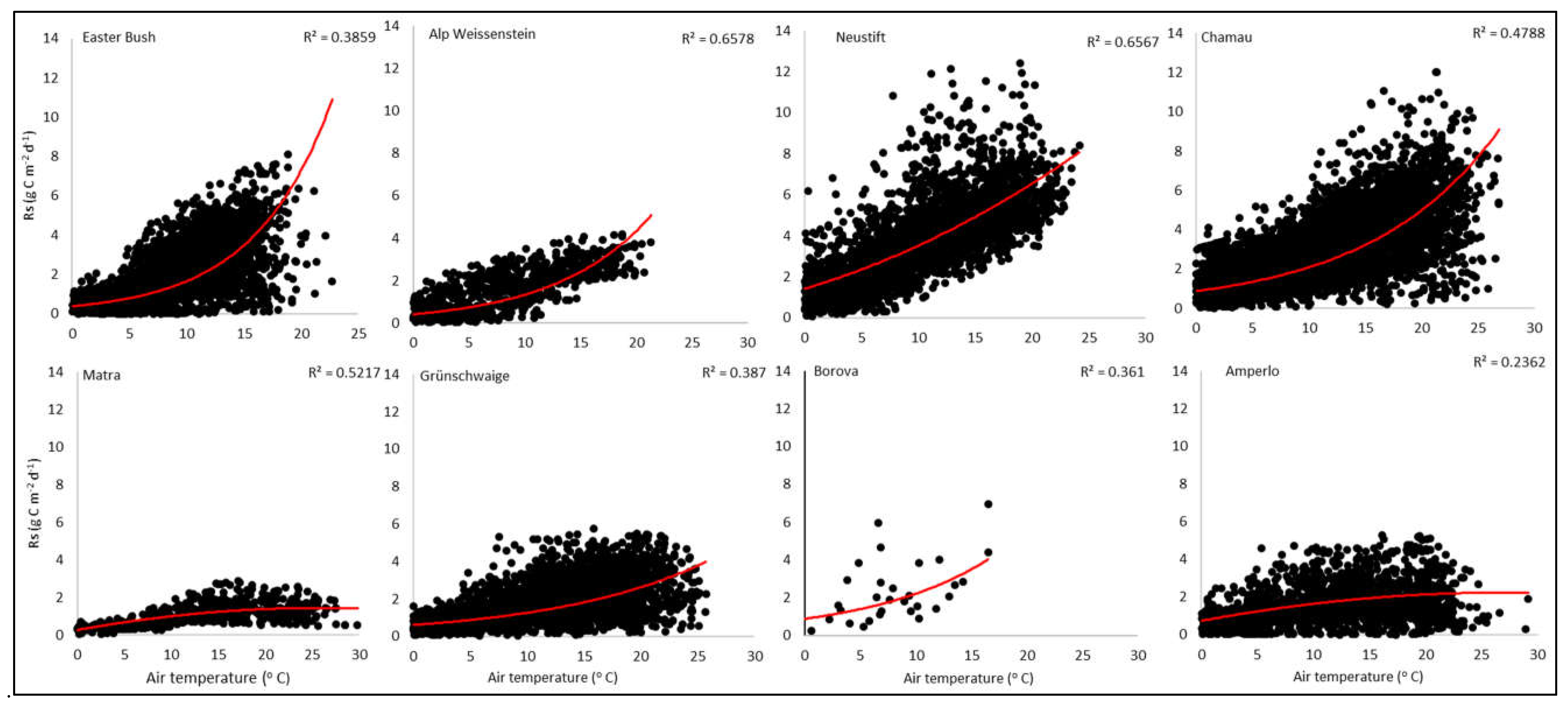
| Site/ location | Coordinates | MAT (°C) |
MAP (mm) |
Type of grassland | Site management | Soil type | Investigated years |
|---|---|---|---|---|---|---|---|
| Easter Bush/ UK* | 55o 52′ N, 03o 02′ W | 9.0 | 947 | Lolium perenne/ clover | Fertilised, grazed, cut | Sandy clay loam | 2002-2010 |
| Alp Weissenstein/ CH | 46o 34′ N, 09o 47′ E | 4.0 | 918 | Mixed grasslands | Extensively grazed | Sandy loam | 2016-2018 |
| Neustift/ AT | 47o 12′ N, 11o 32′ E | 6.5 | 852 | Mixed grasslands | Grazed, cut, manure | Sandy loam | 2002-2012 |
| Chamau/ CH | 47o 12′ N, 08o 24′ E | 9.1 | 1151 | Ryegrass/ clover | Cut, grazed, fertilised | Sandy loam to silty loam | 2005-2018 |
| Matra/ HU | 47o 52′ N, 19o 56′ E | 10.2 | 622 | Mixed grasslands | Cut | Clay soil | 2007-2008 |
| Grünschwaige/ DE | 48o 23′ N, 11o 50′ E | 9.0 | 775 | Ryegrass/ clover | Grazed, manure | Silt loam | 2002-2012 |
| Borova/ CZ | 48o 52′ N, 14o 13′ E | 7.0 | 650 | Ryegrass/ clover | Extensively grazed, fertilised | Sandy loam | 2002-2004 |
| Amperlo/ IT | 41o 90′ N, 13o 22′ E | 10.0 | 1365 | Mixed grasslands | Grazed | Clay soil | 2002-2008 |
| Site/ location | Bulk density (g cm-3) | Soil pH | Clay (%) | Water table depth (cm) | Measured/ estimated SOC (t ha-1) |
|---|---|---|---|---|---|
| Easter Bush/ UK | 1.3 | 5.1 | 23 | 85 | 120 |
| Alp Weissenstein/ CH | 1.1 | 6.4 | 20 | 125 | 32.5 |
| Neustift/ AT | 0.7 | 5.5 | 5.5 | 125 | 43.9 |
| Chamau/ CH | 1.1 | 5.0 | 20 | 125 | 36.7 |
| Matra/ HU | 1.3 | 5.4 | 35 | 400 | 19.5 |
| Grünschwaige/ DE | 1.1 | 6.4 | 26 | 125 | 31.3 |
| Borova/ CZ | 1.1 | 7.8 | 6.0 | 25 | 27.9 |
| Amperlo/ IT | 1.1 | 6.6 | 56 | 125 | 54.2 |
| Site/location | Years of measurements | Cumulative annual estimated Rs (g C m-2) |
Cumulative annual simulated Rs (g C m-2) |
Mean daily estimated Rs (g C m-2) | Mean daily simulated Rs (g C m-2) | RD (%) |
RMSE (g C m-2 d-1) |
d | R2-range |
|---|---|---|---|---|---|---|---|---|---|
| Easter Bush/ UK | 9 | 770 | 490 | 2.11 | 1.35 | -36 | 1.56 | 0.86 | 0.15-0.63 |
| Alp Weissenstein/ CH | 3 | 460 | 260 | 1.25 | 0.72 | -42 | 0.91 | 0.87 | 0.43-0.62 |
| Neustift/ AT | 11 | 1120 | 490 | 3.07 | 1.34 | -56 | 2.51 | 0.28 | 0.20-0.53 |
| Chamau/ CH | 14 | 810 | 430 | 2.92 | 1.55 | -47 | 3.30 | 0.55 | 0.21-0.53 |
| Matra/ HU | 2 | 350 | 530 | 0.95 | 1.45 | 51 | 1.28 | 0.67 | 0.01-0.29 |
| Grünschwaige/ DE | 11 | 530 | 550 | 1.60 | 1.58 | 4 | 1.28 | 0.54 | 0.10-0.53 |
| Borova/ CZ | 3 | 483 | 394 | 1.32 | 1.08 | -18 | 1.05 | 0.87 | 0.0-0.25* |
| Amperlo/ IT | 7 | 450 | 560 | 1.55 | 1.95 | 24 | 1.35 | 0.55 | 0.14-0.44 |
| Site name | Management | Date | Estimated Rs (% change) |
Simulated Rs (% change) |
|---|---|---|---|---|
| Easter Bush | Grass cut | 1/6/2002 | -21 | -10 |
| 5/8/2002 | -12 | -13 | ||
| 29/5/2003 | 20 | 25 | ||
| Slurry application | 28/9/2004 | 15 | 15 | |
| 27/4/2005 | 33 | 0 | ||
| Chamau | Grass cut | 1/5/2005 | -36 | -32 |
| 28/6/2005 | -44 | -31 | ||
| 27/7/2005 | 17 | 8 | ||
| 31/8/2005 | -10 | -14 | ||
| 4/7/2006 | -56 | -24 | ||
| 23/7/2006 | -2 | 2 | ||
| 1/9/2006 | 90 | 55 | ||
| Slurry application | 10/5/2005 | 84 | 67 | |
| 2/6/2005 | 46 | 31 | ||
| 3/8/2005 | 13 | 10 | ||
| 5/12/2005 | -29 | 27 | ||
| 24/3/2006 | 58 | >100 | ||
| 5/5/2006 | -43 | -1 | ||
| 13/6/2006 | >100 | 3 | ||
| 6/7/2006 | 38 | 16 | ||
| 2/8/2006 | -16 | -19 |
| Site/ location | Temp+3 | Temp-3 | Rain+30% | Rain-30% | SOC+30% | SOC-30% | pH+30% | pH-30% | WT+30cm |
|---|---|---|---|---|---|---|---|---|---|
| Easter Bush/ UK | 20.1 | -23.0 | -0.6 | 0.0 | 4.3 | -0.8 | 0.4 | -2.2 | 0.0 |
| Alp Weissenstein/ CH | 25.5 | -22.4 | -17.7 | 10.9 | 2.2 | -2.6 | 0.0 | -6.3 | 11.3 |
| Neustift/ AT | 21.6 | -19.1 | -10.1 | 1.6 | 7.4 | -2.5 | 0.0 | -5.1 | 14.1 |
| Chamau/ CH | 21.4 | -19.2 | -5.5 | 0.0 | 3.1 | -2.5 | 0.0 | -11.1 | 4.7 |
| Matra/ HU | 16.0 | -11.3 | -6.0 | -5.8 | 4.5 | 1.9 | 11.2 | -2.5 | 0.0 |
| Grünschwaige/ DE | 21.8 | -20.1 | -1.4 | 0.0 | 2.1 | -2.2 | 0.0 | -11.5 | 4.8 |
| Borova/ CZ | 22.4 | -21.5 | -1.2 | 1.6 | 0.6 | -0.6 | 0.0 | -6.4 | 16.2 |
| Amperlo/ IT | 24.4 | -22.1 | -7.2 | 5.7 | 15.6 | -2.2 | 5.7 | -15.7 | 8.1 |
Disclaimer/Publisher’s Note: The statements, opinions and data contained in all publications are solely those of the individual author(s) and contributor(s) and not of MDPI and/or the editor(s). MDPI and/or the editor(s) disclaim responsibility for any injury to people or property resulting from any ideas, methods, instructions or products referred to in the content. |
© 2023 by the authors. Licensee MDPI, Basel, Switzerland. This article is an open access article distributed under the terms and conditions of the Creative Commons Attribution (CC BY) license (http://creativecommons.org/licenses/by/4.0/).





